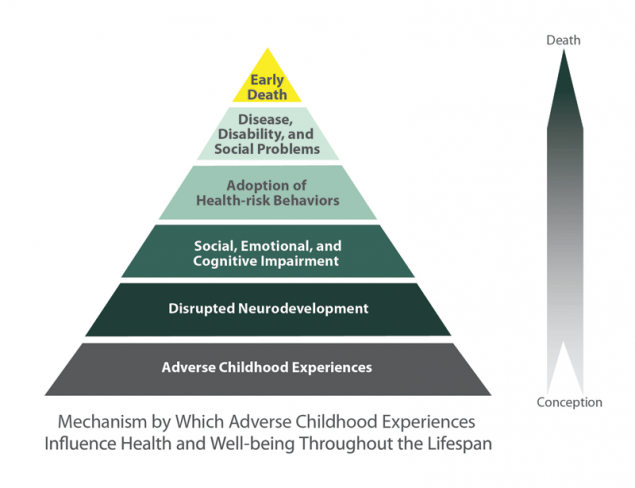The Health, Wellness, and Recovery section of the training guide provides useful resources and information to help people with mental and substance abuse disorders to develop and maintain a healthy lifestyle. It examines the significance and relationship of health, wellness and recovery for people with mental health disorders. There are tools to help people with a self-directed recovery.

According to the National Alliance on Mental Illness (NAMI), people living with a mental illness, on average, die 25 years earlier than the general population. This is largely due to the fact that physical and mental health are fundamentally connected. Chronic medical disorders and complex health needs are expected to co-occur. Medications, in particular atypical antipsychotic drugs, lead to physical health conditions, such as weight gain, high cholesterol, and diabetes that cause early mortality rate for people with mental health conditions. Mental illnesses also result in other declining health habits, such as smoking, poor weight management/nutrition, and physical inactivity. Disabilities and diseases cause a burden that negatively affects a person's well-being.

The World Health Organization (WHO) quantifies the burden of disability associated with a disease or disorder is measured by disability adjusted life years (DALY). DALY is a unit that represents to years lost to disability, illness, or premature death for a given population. DALYs are calculated by adding the number of years of life lost (YLL) to the number of years lived with disability (YLD) for a certain disease or disorder.
The Age Standardized Disability Adjusted Life Years (DALY) rate per 100,000 population, both sexes, 2015 chart, provided by the Kaiser Family Foundation, displays the DALY of various illnesses for men and women in the United States. It shows that mental health and substance abuse disorders are the leading cause of years lost to a disability for men and women in the United States.

A study done by the Center for Disease Control and Prevention (CDC) - Kaiser Peranente discovered the effects of Adverse Childhood Experiences (ACEs). ACEs are traumatic events occurring prior to age 18 that impact a person's future violence victimization and perpetration, and lifelong health opportunities. Traumatic events include poverty, physical abuse, sexual abuse, emotional abuse, physical neglect, emotional neglect, intimate partner violence, mother treated violently, substance misuse within household, household mental illness, parental separation or divorce, and an incarcerated household member. The ACEs test measures child exposure to trauma by quantifying each traumatic event by one unit. Lasting effects of a high ACEs score lead to increased risk for 7 out of 10 leading causes of death, and decreased life expectancy of 20 years. The pyramid chart, from the CDC, shows how ACEs affects a person throughout his/her life.
Safe, stable, and nurturing relationships and environments are key to preventing ACEs. Healthy, safe, and trusting relationships with parents and non-care givers significantly lessen ACEs by reducing consistent stress hormone activation. There are strategies to help prevent ACEs. The CDC identifies strategies to reduce ACEs in communities. These strategies are home visits to pregnant women and families with newborns, parenting skills programs, intimate partner violence prevention, social support for parents, parent support programs for teens and teen pregnancy prevention programs, mental illness and substance abuse treatment, affordable high quality childcare, and sufficient income support for lower income families. Supporting these strategies positively impacts the range of health problems that in communities, and supports skills that help develop and sustain a nurturing environment for children.
| Adverse Childhood Experiences (ACEs) | Counter-ACEs |
| Physical, verbal, or sexual abuse
Physical or emotional neglect An alcoholic parent A family member in jail The disappearance of parent though divorce, death or abandonment A family member diagnosed with a mental illness A mother who is a victim of domestic violence |
Liking school
Teachers who care Opportunities to have fun A predictable home routine Feeling comfortable with yourself Having a caregiver with whom you feel safe Beliefs that provide comfort Having good friends and neighbors |
Maintaining wellness is a means to positively manage physical and mental health. Wellness is a process of becoming aware to make healthy choices to achieve a higher quality of life. It is possible to seek and practice wellness while being ill or stressed. Optimal wellness reduces stress, risk of illness, and creates a path to reach one's full potential. Wellness consolidates various dimensions of a lifestyle in order to address the whole person, and mobilize a person's positive qualities and strengths.
According to the Substance Abuse and Mental Health Services Administration (SAMHSA), combining mental health, substance abuse, and primary care services is the most effective wellness strategy. Below are strategies to maintain wellness.
SAMHSA introduces the eight dimensions of wellness to help develop healthy habits to positively impact physical and mental health. Incorporating the eight dimensions of wellness tackles early mortality from treatable and preventable conditions. The eight dimensions of wellness are as follows:
| Wellness Dimension | Wellness Dimension Description |
| Emotional | Coping effectively and building relationships |
| Environmental | Inhabiting a stimulating, positive, and safe environment |
| Financial | Maintaining good financial habits |
| Intellectual | Engaging in mentally stimulating activities and expand knowledge |
| Occupational | Finding passions to engage in at work |
| Physical | Identifying the necessity for physical activity, a nutritious diet, and sleep |
| Social | Establishing a connection to a trusting, positive support system |
| Spiritual | Identifying a sense of purpose in life |
The video below provides more information on SAMHSA's eight dimensions of wellness.
Incorporating wellness into daily life increases mental and physical health and makes recovery more obtainable. Recovery is a complex concept, especially in terms of mental and physical health. Recovery refers to a return to a state of 'normalcy'. When an individual struggles with mental and/or substance abuse disorders he/she may not know what 'normal' feels like.
Pat Deegan, PhD experienced her own journey through recovery after she was diagnosed with schizophrenia when she was a teenager, and was told that she would not live a 'normal' life. Despite this, she went on to get her PhD and became an advocate for disability rights and promotes recovery and empowerment. The video here is a short clip of Pat Deegan's full-length lecture on recovery. In this video, she describes her experience of diagnosis and recovery.
Recovery is unique to each individual, can be achieved while still experiencing symptoms, and is defined by the individual. SAMHSA's working definition of recovery is "a process of change through which individuals improve their health and wellness, live self-directed lives, and strive to reach their full potential." This definition indicates that recovery is a process directed by the individual.
SAMHSA introduces four major dimensions of recovery: health, home, purpose, and community. Health refers to managing disease or symptoms and making informed decisions that maintain physical and emotional wellbeing. Home refers to a stable and safe place to live. Purpose refers to meaningful daily activities (school, work, volunteering, etc.) that produce independence, income, and resources to successfully participate in society. Community refers to relationships that support friendship, love, and hope.
In addition to the four dimensions of recovery, there are these ten guiding principles:
| Principle | Principle Description |
| Hope | Hope provides a belief that recovery is real, motivates a person for the furutre, and that he/she can overcome challenges. |
| Person-driven | A person defines their own goals and creates his/her own paths to achieve his/her goals. A person uses his/her autonomy and independence to choose services that support his/her recovery and regain control in his/her life. |
| Many Pathways | Understanding that an individual is unique and has unique experiences will help in determining his/her pathway(s). Recovery is based on the whole individual, and thus are personalized and incorporate various resources including professional clinical treatment, medications, family, school, faith, peers, and other resources. Recovery is dynamic and facilitates constant growth, and may include some setbacks. Creating a supportive environment is key to limiting setbacks and fostering recovery. |
| Holistic | Recovery encompasses the whole individual. Areas to address in encompassing the whole individual are self-care practices, family, housing, employment, transportation, education, clinical treatment for mental disorders and substance abuse, services and supports, primary healthcare, dental care, compelementary and alternative services, faith, spirituality, creativity, social networks, and community participation. |
| Peer Support | Sharing experiences, knowledge, and skills are an invaluable resource in recovery. Peer groups help people feel a sense of belonging, supportive relationships, value, and community. A person will find valuable resources in their journey towards recovery. In particular, peer support is important for families with children with behavioral health problems and their recovery. |
| Relational | It is important for a person to be surrounded by people who believe that he/she can recover, offer hope, encouragement, and strategies and resources for change. A person can engage in new, healthy roles that empower him/her through these relationships. |
| Culture | Culture includes values, traditions, and beliefs. Cultures are diverse, and can vary person to person. Services should be culturally grounded, attuned, sensitive, congruent, competent, and personalized to a person's needs. |
| Address Trauma | Trauma is generally a precursor to alcohol and drug use or mental health problems. Services should be trauma-informed and promote safety, trust, empowerment, and collaboration. |
| Strengths/Responsibility | Individuals, families and communities all have strengths and responsibilities. Individuals are responsible for their own self-care, journey towards recovery, socialize with peers, speak about their strengths, needs, and wants. Families are responsible for supporting an individual. Communities are responsible for providing opportunities and resources to address discrimination and foster social inclusion and recovery. |
| Respect | It requires courage to take steps towards recovery. A person needs to acknowledge self-acceptance, develop a positive and meaningful sense of identity, and regain a belief in one's self. Additionally, communities, systems, and societal acceptance and appreciation for people with mental health and substance problems are important in recovery. |
There are a number of resources used to help promote health, wellness, and recovery.
Minnesota Department of Human Services (MDHS) created the MN 10 x 10 initiative, beginning in 2011, to increase the lifespan of people with severe mental health disorders in Minnesota by 10 years in 10 years. People with bipolar disorder or schizophrenia disorder die prematurely from heart disease, lung disease, diabetes, and cancer. The primary reason people with bipolar or schizophrenia disorder fall victim to these diseases are the lack of primary care physician visits. Although these diseases are amongst the leading causes of death, if caught early, they can be prevented by a shift towards a wellness lifestyle. This Minnesota 10 x 10 form is a resource for the client, family members, and providers to stay informed about the client's health and wellness.
The following are Minnesota Health Care Programs that help pay for health care costs:
This guide is a living document. We want to improve it with your help. Do you have questions? Found a typo? Find yourself wanting more information? Please send us your thoughts about anything in this chapter by tapping on the link below.